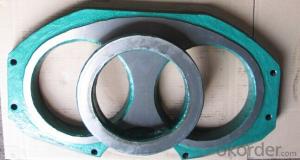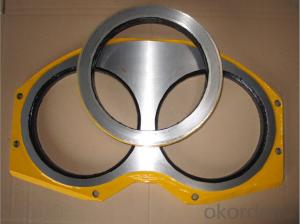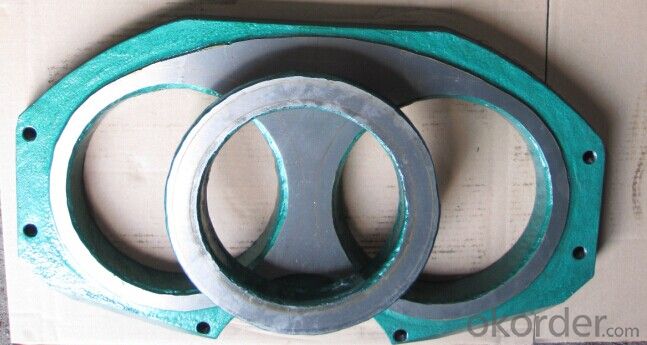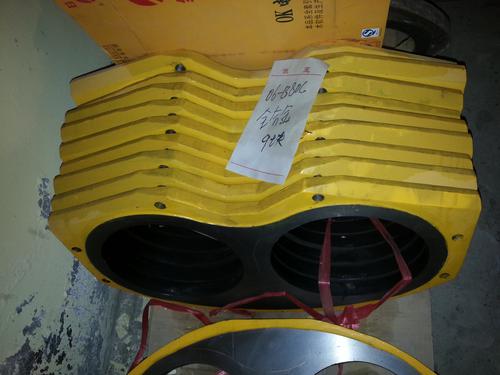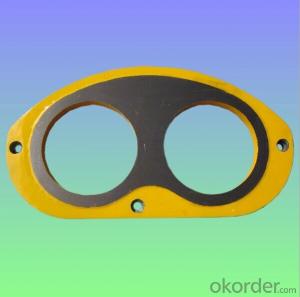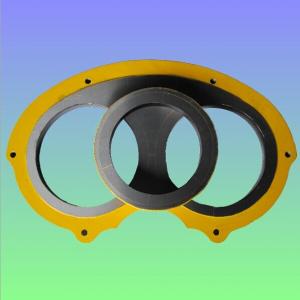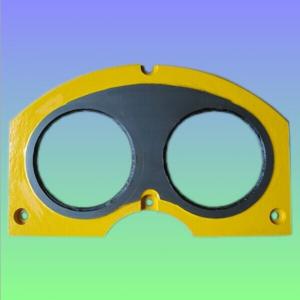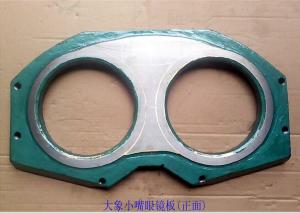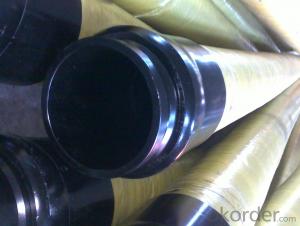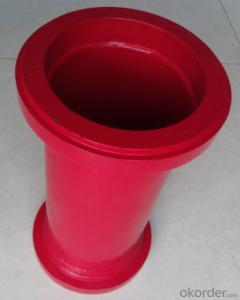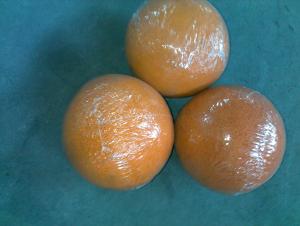PUTZMEISTER Spectacle Wear Plate DN200
- Loading Port:
- Shanghai
- Payment Terms:
- TT or LC
- Min Order Qty:
- 3 pc
- Supply Capability:
- 1000 pc/month
OKorder Service Pledge
OKorder Financial Service
You Might Also Like
Product Name: PUTZMEISTER Spectacle Wear Plate DN200
1. Specification
1. Material: Plate body S35C steel, tungsten carbide E5 grade ,
2. Lifetime: 30,000~80,000cbm
3. HRA≥86
4. Germany Welding rod used for hardfacing
5. tensile strength ≥ 2500 N/mm2
6. Application: trailer and trunk mounted Putzmeister concrete pump
Notes: total series of Concrete Pump Spectacle Wear Plate and Cutting Ring for different brand concrete pump (PUTZMEISTER, SCHWING, CIFA, SANY, ZOOMLION, IHI, KYOKUTO,Niigata Etc) available from us.
2. Application
Our PUTZMEISTER Spectacle Wear Plate and Cutting Ring Tungsten Carbide have been successfully exported to many countries from 1998, Our main markets as below: Middle East, Southeast Asia, America, Brazil, Italy, Russia, South Africa etc
3. Package
Every 60pcs PUTZMEISTER Spectacle Wear Plate and Cutting Ring Tungsten Carbide put in one seaworthy wooden box, and 20 boxes in one 20feet container.
FAQ:
Q1: Why buy Materials & Equipment from us?
A1: All products have its ISO certifications, adheres to the highest standards and a commitment to supply chain safety and customer satisfaction.
Q2: How do we guarantee the quality of our products?
A2: We have established an advanced quality management system which conducts strict quality tests at every step, from raw materials to the final product. At the same time, we provide extensive follow-up service assurances as required.
Q3: How soon can we receive the product after purchase?
A3: Within three days of placing an order, we will begin production. The specific shipping date is dependent upon international and government factors, but is typically 10 to 30 workdays.
Q4: If we can produce some PUTZMEISTER tungsten Carbide Spectacle Wear Plate DN200 according to customers request?
A4: Yes, we can produce PUTZMEISTER tungsten Carbide Spectacle Wear Plate DN200 according to the difference country situations and different concrete pump to make it suitable to the market and customers. We have very professional technical team to make the design.
Q5: How to make a quick resolution for after service?
A5:We have overseas branches all-around of world, IF needed, the seller shall dispatch 2 engineers to the buyer's site for supervision of training. The buyer shall make available of necessary facilities &skilled personnel at site for training.
Image:
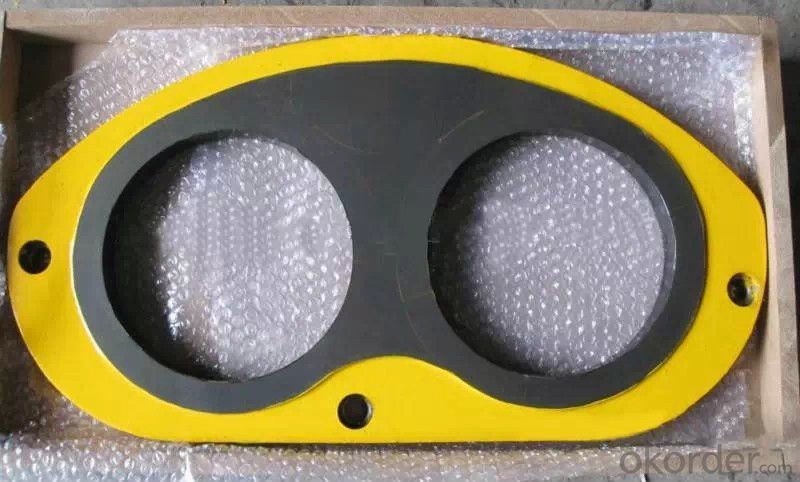
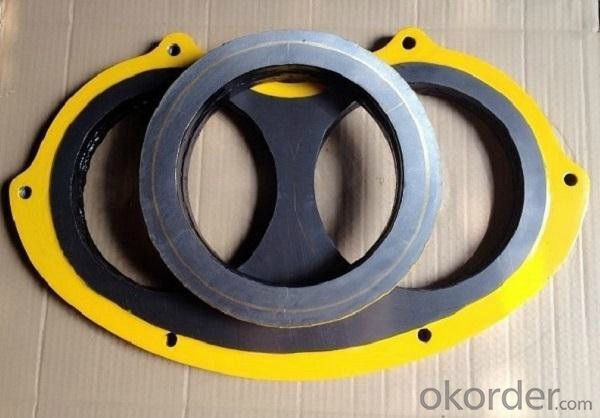
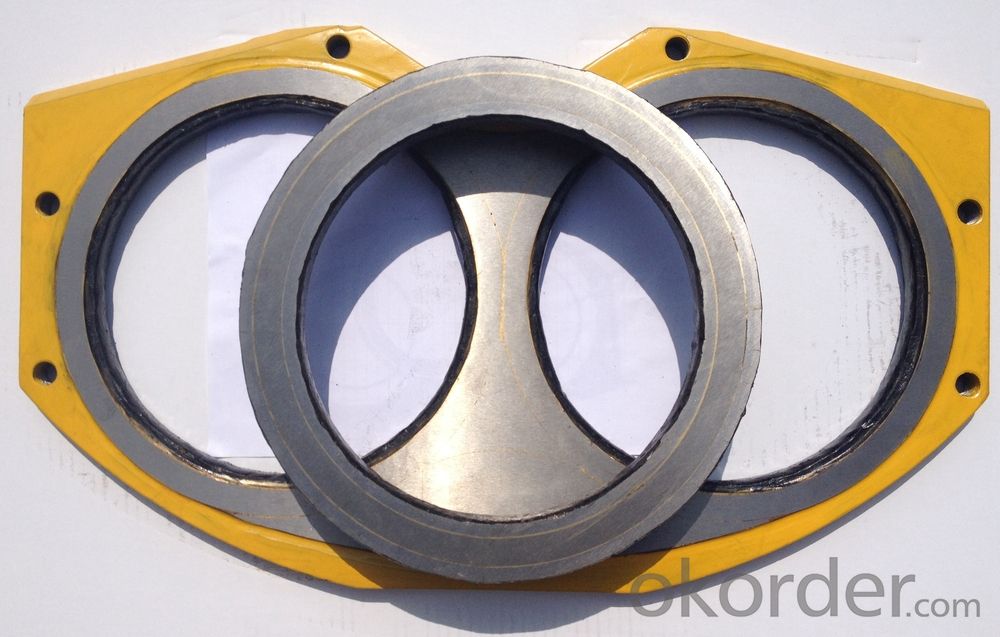
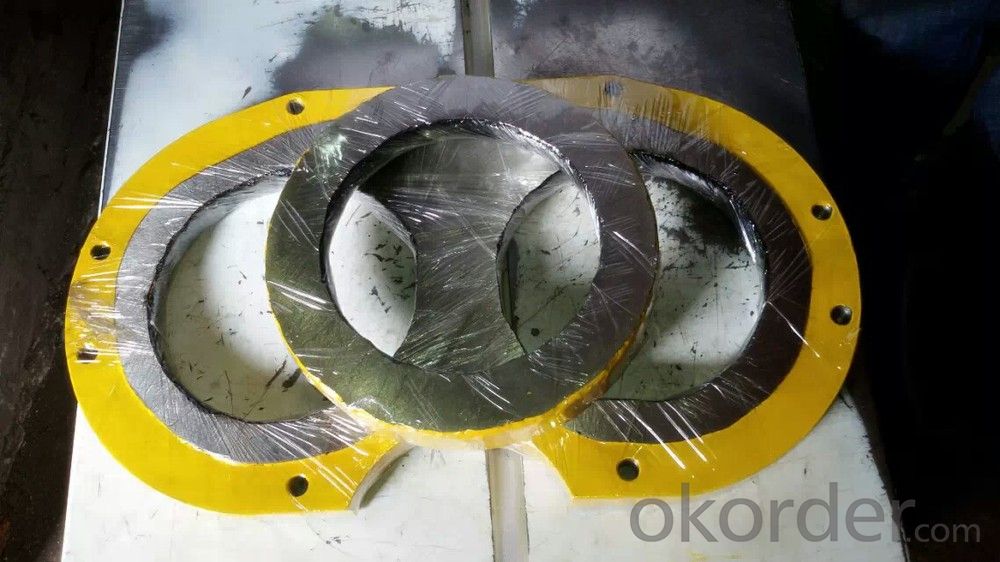
- Q: How does a concrete pump agitator motor prevent concrete from settling?
- A concrete pump agitator motor prevents concrete from settling by continuously rotating and agitating the mixture, ensuring that the aggregate, cement, and water remain well-mixed. This agitation action prevents the heavier components from sinking and settling at the bottom, maintaining a homogeneous consistency throughout the concrete.
- Q: How often should concrete pump agitator motors be inspected and replaced?
- Regular inspections should be carried out on concrete pump agitator motors to ensure proper functioning and identify potential problems before they escalate. The frequency of inspections depends on factors such as workload and operating conditions. However, a general rule of thumb is to inspect the motors at least once per year or after every 500 hours of operation, whichever comes first. Monitoring the performance of the motors is crucial when considering replacement. If there are any indications of motor failure, such as overheating, excessive noise, or reduced efficiency, it may be necessary to replace the motor sooner rather than later. Additionally, if the motor fails any inspections or tests, immediate replacement is necessary to prevent safety hazards or disruptions in the concrete pumping process. Ultimately, prioritizing regular inspections and maintenance is key to prolonging the lifespan of the agitator motors and ensuring optimal operation. Following manufacturer guidelines, seeking advice from experts, and conducting routine checks will help determine the appropriate timing for inspections and replacements.
- Q: Which is the best home made concrete pump car?
- The second is heavy Futian Fortaleza, Xiangjian, Xugong, honedeli, the price is high, basically there is no big problem
- Q: What are the signs of a damaged concrete pump accumulator?
- There are several signs that indicate a damaged concrete pump accumulator. One of the most common signs is a decrease in the pumping efficiency. If you notice that the concrete pump is not able to pump the concrete as effectively as it used to, it could be a sign of a damaged accumulator. Another sign is a decrease in the pressure of the concrete being pumped. If you notice that the pressure is not as strong as before, or if there are sudden drops in pressure during pumping, it could indicate a problem with the accumulator. Leaks around the accumulator are also indicative of damage. If you notice any fluid leaks around the accumulator, it could mean that the accumulator is damaged or the seals are worn out. This can result in a loss of pressure and inefficiency in pumping. Unusual noises coming from the concrete pump can also be a sign of a damaged accumulator. If you hear any strange noises, such as knocking or hissing sounds, it could be a result of a damaged accumulator. Lastly, if you observe any visible damage on the accumulator itself, such as cracks or dents, it is a clear sign of damage. These damages can compromise the integrity of the accumulator and affect its performance. In summary, signs of a damaged concrete pump accumulator include decreased pumping efficiency, decreased pressure, leaks, unusual noises, and visible damages. If you notice any of these signs, it is important to address the issue promptly to prevent further damage and ensure the smooth operation of the concrete pump.
- Q: How often should concrete pump hydraulic oil coolers be inspected and maintained?
- To guarantee optimal performance and avoid possible problems, it is necessary to carry out regular inspections and maintenance on the hydraulic oil coolers of concrete pumps. The frequency of these procedures will vary depending on factors such as the pump's operating conditions, workload, and the recommendations provided by the manufacturer. As a general rule, it is advisable to inspect and maintain the concrete pump hydraulic oil coolers at least once every six months or every 500-700 operating hours, whichever comes first. However, in more demanding or extreme operating conditions, it may be necessary to perform these tasks more frequently. During these inspections, it is of utmost importance to thoroughly clean the cooler and examine it for any signs of damage, corrosion, or leaks. It is also crucial to inspect the cooler's fins for any blockages, as the presence of debris or dirt can decrease its efficiency. Regularly checking and replacing the air filters of the cooler is equally important to ensure proper airflow and prevent overheating. In terms of regular maintenance, it is vital to replace the hydraulic oil and filters according to the manufacturer's recommendations. This action helps maintain the oil's viscosity and prevents any contaminants from causing damage to the cooler or other hydraulic components. To summarize, conducting regular inspections and maintenance on concrete pump hydraulic oil coolers is crucial to ensure efficient operation and prolong their lifespan. By adhering to the manufacturer's guidelines and taking into account specific operating conditions, it is possible to determine the appropriate frequency for these inspections and maintenance tasks.
- Q: What is the concrete delivery pump?
- The utility model relates to a machine for continuously conveying concrete along a pipeline by utilizing pressure, which is mainly used for building, bridges and tunnels
- Q: How often should concrete pump seals be replaced?
- The frequency at which concrete pump seals should be replaced depends on several factors, including the type of pump, the quality of the seals, the operating conditions, and the maintenance practices. Generally, it is recommended to inspect and replace concrete pump seals every 500 to 1,000 pumping hours or annually, whichever comes first. Regular inspection is crucial to identify any signs of wear or damage in the seals. Common indications for replacement include leaks, excessive vibration, reduced pumping efficiency, or visible degradation of the seal material. If any of these issues are observed, it is essential to promptly replace the seals to prevent further damage and ensure the optimal functioning of the concrete pump. It is worth noting that certain pumps may require more frequent seal replacements due to their design or operating conditions. For example, high-pressure pumps or those used in abrasive environments might experience accelerated wear on the seals, necessitating more frequent replacements. To prolong the lifespan of concrete pump seals, proper maintenance and care are essential. This includes regular cleaning of the pump and seals, ensuring proper lubrication, and following the manufacturer's guidelines for operation and maintenance. Additionally, using high-quality seals and regularly inspecting them for signs of wear can help extend their longevity. Overall, the replacement frequency of concrete pump seals should be determined through a combination of regular inspections, adherence to maintenance practices, and consideration of the specific operating conditions.
- Q: How can one determine the correct voltage and current rating for electrical components in concrete pump spare parts?
- To determine the correct voltage and current rating for electrical components in concrete pump spare parts, several factors need to be considered. Firstly, it is essential to consult the manufacturer's specifications and documentation for the concrete pump and its spare parts. These documents usually provide detailed information about the voltage and current requirements for each electrical component. Paying close attention to these guidelines ensures that the components are operated within their designed parameters. Secondly, it is crucial to understand the electrical system and its requirements. This involves analyzing the power supply available at the site where the concrete pump will be used. Factors such as the voltage level (e.g., 110V, 220V, 440V) and frequency (e.g., 50Hz, 60Hz) of the electrical supply need to be taken into account. Additionally, the maximum current capacity of the electrical system must be considered to prevent overload situations. Furthermore, it is advisable to assess the specific application and operating conditions of the concrete pump. Different components may have varying voltage and current requirements depending on their function and the environment in which they are used. For instance, components installed in outdoor areas may require higher voltage ratings to withstand harsh weather conditions. Lastly, seeking professional assistance from qualified electricians or engineers is highly recommended. They possess the expertise and knowledge to accurately determine the voltage and current ratings for electrical components in concrete pump spare parts. Their experience allows them to consider various factors such as safety regulations, compatibility with the existing electrical system, and any specific requirements of the concrete pump manufacturer. By taking into account the manufacturer's specifications, understanding the electrical system, considering the application and operating conditions, and seeking professional advice, one can effectively determine the correct voltage and current rating for electrical components in concrete pump spare parts.
- Q: Can I reuse old concrete pump spare parts?
- Yes, old concrete pump spare parts can be reused as long as they are in good condition and meet the required specifications for the pump. However, it is important to properly inspect and test the parts before reuse to ensure they will function safely and efficiently.
- Q: How do I properly maintain and replace wear plates in concrete pump spare parts?
- Achieving optimal performance and durability for your equipment relies heavily on the proper maintenance and replacement of wear plates in concrete pump spare parts. To ensure that your wear plates are adequately maintained and replaced, the following steps can be taken: 1. Conduct regular inspections: It is crucial to regularly inspect the wear plates in your concrete pump spare parts in order to identify any signs of wear or damage. Look for visible indications such as cracks, excessive wear, or deterioration. 2. Thoroughly clean the area: Prior to replacing the wear plates, it is essential to thoroughly clean the surrounding area. Remove any debris, dirt, or hardened concrete that may be present. Utilize a pressure washer or wire brush to effectively clean the surface. 3. Measure the thickness of wear plates: Utilize a precision measuring tool to determine the thickness of the wear plates. Compare the current thickness with the manufacturer's recommended specifications to determine if replacement is necessary. If the wear plates are below the recommended thickness, replacement is required. 4. Remove the old wear plates: Carefully remove the old wear plates using the appropriate tools. Take note of their positions and any alignment marks to ensure proper installation of the new plates. 5. Prepare the new wear plates: Prior to installing the new wear plates, verify that they are the correct size and meet the required specifications for your concrete pump. Inspect the new plates for any defects or damage before proceeding. 6. Apply lubrication: Apply a thin layer of lubricant or anti-seize compound to the mating surface of the new wear plates. This will aid in preventing corrosion and facilitate future replacements. 7. Install the new wear plates: Position the new wear plates accurately, aligning them with any reference marks or indicators. Secure them tightly using suitable bolts or fasteners, taking care not to overtighten. 8. Test and check alignment: After installing the new wear plates, perform a test run of the concrete pump to ensure proper functionality. Check for any leaks, uncommon vibrations, or misalignments. If any issues are detected, address them promptly. 9. Establish a regular maintenance schedule: To prevent premature wear and damage to the wear plates, create a routine maintenance schedule. This may involve cleaning, lubricating, and inspecting the wear plates at specified intervals or after a certain number of operational hours. By adhering to these steps and adopting a proactive approach to wear plate maintenance and replacement, you can guarantee the seamless operation and extended lifespan of your concrete pump spare parts.
Send your message to us
PUTZMEISTER Spectacle Wear Plate DN200
- Loading Port:
- Shanghai
- Payment Terms:
- TT or LC
- Min Order Qty:
- 3 pc
- Supply Capability:
- 1000 pc/month
OKorder Service Pledge
OKorder Financial Service
Similar products
Hot products
Hot Searches
Related keywords
